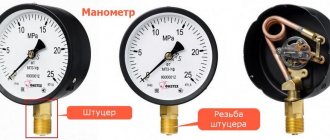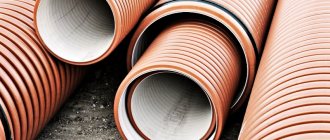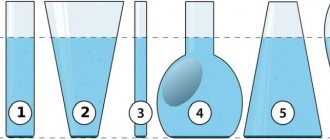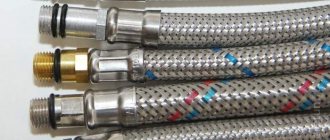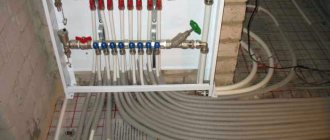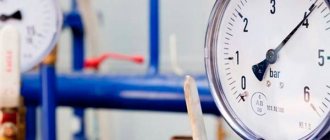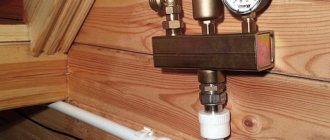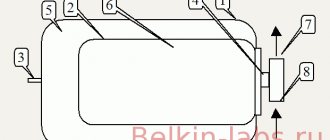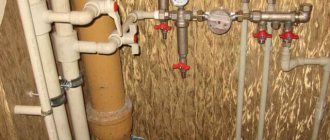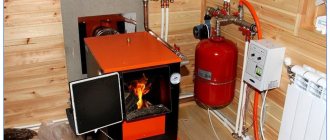One of the most important indicators in public and individual water supply networks is water pressure, designed to ensure the convenience of the user of sanitary appliances and the functioning of household appliances and water heating equipment. The water pressure in the water supply must be maintained at a certain level, regulated by standards in multi-apartment communal buildings (MCD) and set independently by the owners of individual residential buildings.
Knowledge of standards can be useful when pressure characteristics deviate from standardized standards in residential apartment buildings, creating problems when using cold and hot water. In this case, by taking measurements independently or with the help of specialists, it is possible to achieve official adoption of measures to normalize the pressure parameters of water supply established by regulatory documents and recalculate utility bills.
Rice. 1 Pressure gauges in domestic autonomous water supply systems
What is it and the units of measurement of water pressure
Any liquid, having its own mass and being in an open container, acts on its surface with the same force in all directions, proportional to its weight and spreading area. This pattern in the properties of liquids was first noticed and analyzed experimentally by Blaise Pascal in 1653, therefore the unit of measurement of the pressure of a liquid column in a static (stationary state) at a conventional level also received a similar name Pascal.
Pascal is referred to the SI international measurement system and is taken equal to the pressure exerted by a force of 1 Newton on a surface area of \u200b\u200bone square meter (1 Pa = 1N/m2).
Since Pascal, by technical standards, is too small a measuring unit (it creates a force on the surface equal to 1 kg of a substance scattered over an area of 1 square meter), then in state standards and technical documentation the user is more often faced with the following larger units of measurement:
Megapascal (Mpa) is a popular technical unit of pressure, equal to 106 Pa, approximately equal to 100 m of water and related to the atmosphere as follows: 1 atm. = 0.1 MPa or 1 MPa = 10 atm. Megapascal is widely used in regulatory documents (state standards, sanitary norms and rules) to indicate the technical characteristics of the working environment, pipes, fittings, and equipment.
A meter of water column is a value four orders of magnitude greater than Pascal (1.0197⋅104 Pa), the most convenient from a practical point of view. It shows to what height water at a temperature of + 4 °C can be raised when applying a given force. A meter of water column is an order of magnitude less than one atmosphere or bar, an indicator often used in the technical characteristics of water pumping equipment (submersible borehole and well electric pumps, surface stations).
When purchasing an electric pump, if its pressure parameters are indicated in meters, the consumer immediately has a complete idea to what height the unit can raise water from a well or borehole. It is also very convenient to use meters of the water column when calculating the length of water supply lines, leaving the length of the vertical sections unchanged and converting the distances of the horizontal sections into the standard ratio of 1 to 10 with a pipe internal diameter of 1 inch.
In technical documentation, the unit of hydrostatic pressure is sometimes indicated in millimeters of water column, mm. water Art., rarely used in practical areas of hydraulic engineering.
Rice. 2 Table of relationships between measuring units
Atmosphere. The technical (10.197⋅104 Pa) or physical (9.8692⋅104 Pa) atmosphere shows the force of influence of 1 kg of water (kgf) on an area the size of a square centimeter. The atmosphere is used in almost all technical areas: regulatory documents, physical characteristics of hydraulic equipment, fittings, working environment.
The bar is a measuring unit, exactly 5 orders of magnitude smaller than Pascal, together with the atmosphere, it is widely used to indicate the hydraulic characteristics of pumping, water heating equipment, various types of fittings and automation devices.
Kilogram-force per square centimeter (kgf/cm²) is a measurement unit that is present in almost all sanitary norms and rules, as well as in state standards, and is most often indicated in tables.
From the given values of measuring units, we can conclude that three of them are bars, atmospheres, and kilogram force per square meter. see approximately equal to each other. In almost any simplified household calculations, minor differences in the readings of the given units can be ignored.
The height of the water column is approximately 10 times smaller than the previous listed measurement units, and one megapascal, on the contrary, is approximately 10 times larger.
Rice. 3 Standards from the Decree of the Russian Federation of May 6, 2011 N 354
Standards
Pressure standards in the water supply system are regulated by SNiP 2.04.02-84 and 2.04.01.85.
According to these documents, their permissible boundaries must be within the following limits:
- Cold water supply 0.3-6 atmospheric units;
- Hot water supply 0.3-4.5 atmospheric units.
These are extremely acceptable values at which the system will operate. But how to work is a completely different question. But first things first.
How is pipeline pressure measured?
The unit of pressure measurement is 1 bar. This is the pressure that a ten-meter column of water creates on the surface.
It is also often measured in atmospheric units, which in their digital values are almost equal to a bar. More precisely, 1 bar = 1.0197 atm. The difference is insignificant, so it doesn't really matter.
What pressure is considered optimal?
According to the same building codes, the working pressure of cold water supply in an apartment building should be equal to four atmospheres.
Water supply and distribution system in a multi-storey building
But in reality it may turn out to be both higher and lower than this value - depending on what floor the apartment is located on, and on the activity of water consumption by the neighbors. Small deviations in one direction or another are acceptable, and 4 bar at the inlet is the pressure that will ensure comfortable and safe use of the system for all consumers.
The situation is somewhat different with private low-rise buildings. Since the maximum height of water rise in them rarely exceeds 10 meters, other water supply standards apply here: a pressure of 2-3 bar is considered normal.
Private house water supply system
All of the above applies mainly to cold water supply. The operating pressure in the hot water supply system may be lower, since the main appliances, which require a certain pressure for normal operation, are powered from the cold water supply.
Each of these devices has its own standard water supply pressure:
- The maximum “requests” for a bathtub with a Jacuzzi system - it requires a pressure of 4 atmospheres for normal functioning;
- About the same amount, or a little less, is needed to irrigate a large area through stationary sprayers;
- Washing machines and dishwashers will not operate at pressures below 2 bar;
- You can take a shower comfortably if the minimum pressure in the system is 1.5 atmospheres;
- At least 1.5-2 atmospheres will be required for autonomous fire extinguishing devices if the house is equipped with such a useful system.
Sprinkler of autonomous fire extinguishing system
Advice. When purchasing such household appliances, always pay attention to its performance characteristics, including the minimum pressure for which it is designed. A consultant or the instructions for the device will help you obtain this data.
In a private house with an autonomous water supply, it must be designed in such a way that the pressure in the system is sufficient for all consumers - even with all taps and appliances operating at the same time. In other words, the pump should be taken with a power reserve.
How and how pressure in the system is measured
Pressure in pipelines is measured with special devices - pressure gauges.
The pressure gauge shows normal water supply pressure
- They are always installed on heating systems, and heating boilers are most often supplied complete with a pressure gauge.
- They are also used to supply water to apartment buildings.
- But for private owners, if they want to control the pressure in the water supply system, they need to take care of this themselves by installing a measuring device next to the meter with their own hands.
To know what pressure is in the pipes at any moment, you need to install pressure gauges on them
These household measuring instruments can have a scale from 0 to 6, 7, and even 10 atmospheres. Such surges and periods of water supply under high pressure are indeed possible in the network. But it is advisable to prevent them, keeping the pressure in the range from 1.5 to 4 bar.
Note. At lower pressure, water-consuming appliances will not turn on, and it will become inconvenient to use the shower. But too high pressure can cause much more trouble, leading to leaks, broken valves and other plumbing fixtures. Especially if this is the operating pressure in the hot water supply.
What is the water pressure in the water supply of an apartment building?
Government Decree of the Russian Federation dated May 6, 2011 No. 354, which regulates the procedure for providing utility services to citizens living in apartment buildings or using premises there for various purposes, stipulates the maximum and minimum pressure in the hot (DHW) and cold (CW) water supply lines.
The generally accepted pressure of cold water at the water intake point is from 0.03 MPa (0.3 kgf/cm2, atm., bar) to 0.6 MPa (6 kgf/cm2, atm. bar).
For water taps, which can be used by residents in the absence of water supplies, the minimum pressure is set at 0.1 MPa (1 kgf/cm2).
For hot water supply, existing standards at the water point are just below the cold water supply and range from 0.03 MPa (0.3 kgf/cm2) to 0.45 MPa (4.5 kgf/cm2).
The given standards apply to the hours of maximum intake in the morning from 7.00 to 9.00 and in the evening from 19.00 to 22.00, that is, at the time when consumption volumes from the main line are at their highest.
Rice. 4 Consumption standards per resident of apartment-type buildings according to SNiP 2.04.01-85*
Free head
It is clear that the pressure in the internal apartment water supply of high-rise buildings is directly related to its parameters at the inlet; SNiP 2.04.02-84 regulates its values in external water-bearing networks, the main points of the document:
- According to the standards, the pressure in the city water supply of populated areas, taking into account the maximum volumes of consumption for household and drinking needs at the entrance to buildings, is assumed to be at least 10 m (1 atm.). When calculating the required pressure at the entrance of high-rise buildings, 4 m are added to each floor.
- If it is possible to regulate the pressure in the main network at the entrance to the building, then it is permissible to add 3 m of pressure to each floor. In this case, the building should be equipped with reservoirs for storing water reserves.
- If buildings of different heights or built on hills are connected to external water supply networks, it is permissible to install local pumping equipment to increase pressure in high-rise buildings and structures built at heights.
- Since the water taps are connected to external water-bearing networks and are located at the height of the house inlets located at ground level, the minimum pressure in them is taken to be 10 m.
- The maximum input pressure into buildings for water supply networks for household and drinking purposes should not be higher than 60 m.
- If individual buildings or areas are connected to an external water supply network with a pipe pressure of 60 m, regulators are used to compensate for excess pressure or the water supply system is divided into zones.
- In addition to water supply networks for household needs and drinking purposes, low and high pressure fire lines are laid in populated areas.
- For low-pressure fire-fighting pipelines, a pressure of at least 10 m is assumed. If the branches for drinking water and fire-fighting purposes are combined, the maximum pressure level should not be higher than 60 m.
Definition
In order for the water supply network to function stably, water utility employees regularly maintain the specified number of atmospheres in it. The force of fluid movement in pipes is determined by a physical quantity that is equal to the degree of influence of the liquid medium on their walls. Systematic adjustment of H2O movement indicators allows aquifer structures to operate fully, without the likelihood of accidents. Such as:
- breakthrough of highways;
- valve failure;
- failure of plumbing, etc.
Pressure in the water supply system of a private house
Country cottage-type residential buildings can be connected to both centralized hot and cold water supply lines and to an autonomous water supply line.
Typically, the containers for water intake for household and drinking water during individual water supply are wells and borehole sources, from which water resources are directed to the house.
The most common water supply scheme is implemented using submersible electric pumps or surface pumping stations, which send water from a well or borehole source through HDPE pipes to buildings. In this case, water is constantly in the internal water supply, and the pump automatically turns off if water resources are not used and turns on when water is consumed.
Sometimes, with autonomous water supply, situations arise when the flow rate of a borehole or well source is small and it cannot provide water intake in the required volumes for a long time. In this situation, the solution is to use a storage tank, which is installed as high as possible (on the top floor or attic of the building) and filled with water using an electric pump.
Rice. 6 Scheme and type of water supply with a hydraulic accumulator
Basic equipment for autonomous water supply
A standard autonomous water supply system includes a water supply unit (submersible or surface electric pump), a pressure switch and, if necessary, dry running, a hydraulic accumulator, and a pressure gauge. When drawing water, the pump fills the internal pipeline and expansion tank with water, and the hydraulic relay in the water supply network is the main automation device. It turns off the power supply to the pumping unit when a certain pressure is reached in the line.
The upper and lower limits for turning on and off the electric pump are set manually when setting up the relay; each of the devices offered on the market has its own range and pressure limit values.
Optimal pressure for a typical water supply scheme
A standard relay for operation in the water supply system of a one-story house is designed for an operating pressure in the water supply network of approximately 1.5 to 3 bar (popular relay models include factory settings for the operating range from 1.4 to 2.8 bar). It is worth noting that the indicator of 3 bar is approximately equal to the average value between the established standards for apartment buildings of indicators from 0.3 to 6 atm.
Rice. 7 Water supply scheme with water intake from a well with a storage tank
If an individual house has a height of two or more floors, by analogy with the pressure indicators of a multi-storey building, 0.5 bar is added to each floor. Considering that the internal water supply of an individual residential building is much longer than in city apartments, and accordingly it has higher hydraulic losses, the figure of 0.5 bar is sometimes increased to 1.
That is, at the entrance of the internal cold water pipeline to a private house, with the most common height being two to three floors, a relay with a response threshold of approximately 3.5 to 5 bar can be installed and, accordingly, the pressure at the external input can reach up to 50 m.
Pressure norm when using a storage tank A storage tank located on the top floor or attic of a country house creates a pressure equal to the height of its location above ground level. The water volume for filling the container is provided by a submersible electric pump or pumping station with intake from a well or borehole.
If in a two-story house the distance between the basement and the attic can reach 10 m, which is equivalent to a pressure of 1 bar and is quite sufficient for the operation of a gravity heating system, then in the case of water consumption by plumbing fixtures and water heating equipment, this value may not be enough for their normal functioning. The owner will have to take measures to increase the hydraulic pressure; usually for these purposes a special booster electric pump is built into the pipeline circuit.
Rice. 8 Dependence of the service life of polypropylene pipes on their temperature and pressure parameters
It might be useful to read about the water supply protection zone
Methods for determining power
Determining the value is not difficult using a built-in or portable pressure gauge. The first option involves installing a measuring device in advance (at the time of construction or repair work) at the point of supplying the home water supply to the home.
The second involves making the meter yourself by connecting a threaded extension to an adapter. The main thing is to make sure that everything is completely sealed. After preparation, disconnect the shower nozzle from the shower hose and connect a measuring device to it. Then the fluid supply is activated and the readings are recorded.
During measurements, the use of any household appliances connected to the water supply network is not allowed.
Types of pipeline pressures
Any user who independently deals with water supply often encounters various terms that determine the pressure in the water supply system, the main ones (according to GOST 356-80 (ST SEV 253-76):
Nominal PN. When purchasing pipes for water supply installation on the construction market, you are often faced with an indication of their service life; for products made from different materials it is different and ranges from 20 years for steel and 50 years for polymers.
The user should be aware that the PN indicator means that the pipe at a given maximum excess pressure can operate for the specified operational period under the only condition - the temperature of the working environment should not exceed a threshold of + 20 ° C.
Working Rr. It is known that as the temperature of the transported medium increases, the service life of any pipelines decreases. In the heating circuit, the coolant temperature usually does not go beyond the range of 50 - 70 °C for radiators and 35 - 50 °C for heated floors, that is, the nominal PN for these pipes is not relevant.
Pascal's law
The fundamental basis of modern hydraulics was formed when Blaise Pascal discovered that the action of fluid pressure is constant in any direction. The action of liquid pressure is directed at right angles to the surface area.
If a measuring device (pressure gauge) is placed under a layer of liquid at a certain depth and its sensitive element is directed in different directions, the pressure readings will remain unchanged in any position of the pressure gauge.
That is, the fluid pressure does not depend in any way on the change in direction. But the fluid pressure at each level depends on the depth parameter. If the pressure meter is moved closer to the surface of the liquid, the reading will decrease.
Accordingly, when diving, the measured readings will increase. Moreover, under conditions of doubling the depth, the pressure parameter will also double.
Pascal's law clearly demonstrates the effect of water pressure in the most familiar conditions for modern life.
Hence the logical conclusion: fluid pressure should be considered directly proportional to the depth parameter.
As an example, consider a rectangular container measuring 10x10x10 cm, which is filled with water to a depth of 10 cm, which in terms of volumetric component will be equal to 10 cm3 of liquid.
This volume of water of 10 cm3 weighs 1 kg. Using the available information and the calculation equation, it is easy to calculate the pressure at the bottom of the container.
For example: the weight of a column of water with a height of 10 cm and a cross-sectional area of 1 cm2 is 100 g (0.1 kg). Hence the pressure per 1 cm2 area:
P = F / S = 100 / 1 = 100 Pa (0.00099 atmospheres)
If the depth of the water column triples, the weight will already be 3 * 0.1 = 300 g (0.3 kg), and the pressure will triple accordingly.
Thus, the pressure at any depth of a liquid is equal to the weight of the liquid column at that depth divided by the cross-sectional area of the column.
Water column pressure: 1 - wall of the liquid container; 2 — pressure of the liquid column on the bottom of the vessel; 3 — pressure on the base of the container; A, C - areas of pressure on the sidewalls; B - straight water column; H - height of the liquid column
The volume of fluid creating pressure is called hydraulic fluid head. The fluid pressure, due to hydraulic pressure, also remains dependent on the density of the fluid.
How to reduce blood pressure
The problem of high pressure is usually faced by residents of the lower floors of high-rise buildings, where to ensure the required range is 0.3 - 6 atm. at the top you have to supply water with increased pressure from below. Excessive pressure in the circuit leads to accelerated wear of pipeline fittings, inconvenience when using mixing devices and sanitary equipment (increased noise in taps).
The problem in apartment buildings is solved quite simply - in order to reduce the pressure, valves at the entrance to the apartment from the cold water or hot water risers reduce the cross-section of the passage channel.
If sudden changes in pressure are observed in the system, a reducer can be used to reduce or stabilize it. The device has a regulator that allows you to lower the pressure by setting the maximum permissible pressure at the entrance to the apartment (for example, readings of 2 or 3 atm), the threshold value of which cannot be exceeded.
In the autonomous water supply of country houses, the problem of too high a pressure is solved at the installation stage - the adjusting screw on the hydraulic relay is tightened, which lowers the upper threshold of its operation.
Rice. 10 Boost pumps that increase water pressure in the water supply and their use
Measurements
A device for measuring water pressure in a water supply system, as we know, is called a pressure gauge. The price of the most affordable pressure gauges starts from approximately 150-200 rubles; But, digital devices can cost between units and tens of thousands.
The method of measuring the parameter we are interested in with our own hands is extremely simple:
- The device, wrapped with flax or other sealing material, is screwed into the control valve.
- The valve opens, after which the measurement is removed.
Control valves for taking measurements are constantly present in the elevator unit (supply, return and mixture at the end of the elevator) and in the water meter (in most cases, before and after the end of the meter). If you need to take a measurement at an arbitrary point in the water supply system, this can be easily done by screwing a pressure gauge instead of a plug into one of the risers and running it.
As always, there is a sequence of subtleties.
- In order to get a detailed picture of the operation of the water supply system, measurements must be taken during the peak water intake, which occurs in the evening hours.
- The device, which is always connected to the water supply, often “sticks”: the arrow gets stuck in one position. To prevent this from happening, instead of a control valve, a three-way valve with a drainage hole is installed, which allows water to be discharged from its body at the end of the measurement.
- The brass pipe threads of the invariably removed device wear out quickly. A simple instruction will help solve the problem: equip the pressure gauge with a metal extension.
How to increase pressure
In an apartment or cottage-type house, the pressure in the pipeline can be increased in the only way - by installing a special booster pump in the pipeline.
The unit, with its impeller blades, will push water through the pipes at increased speed, thereby creating increased pressure in the line.
In multi-storey apartment buildings, a situation may arise when the use of a booster electric pump in an apartment will lead to pumping out water from the risers of consumers on the upper or lower floors. To avoid complaints from neighbors and possible troubles, one option is to install a storage tank in the apartment. A float switch is installed in it, which has an automatic shut-off valve connected inside to the lever, and the inlet pipe is connected to the water supply. After filling the tank with water, the float rises and shuts off the water supply (the operating principle is similar to the toilet filling system).
Since the storage tank cannot always provide the required pressure in the apartment, a booster pump is additionally installed in the line, which automatically turns on when the pressure in the pipeline is 0.2 or 0.3 bar.
Rice. 11 Measurement of pressure in the apartment
Computational and experimental methods
Determining the network pressure is possible not only with the help of specialized instruments, but also with the use of home-made devices and calculation formulas of hydrodynamics. An example of computational and experimental methods is the determination of pressure using a hose and the calculation method through water flow.
Water pressure regulator diagram.
In other words, a hydraulic calculation of the existing system must be carried out with sufficiently large assumptions to omit:
- hydrodynamic resistance of individual sections of the pipeline;
- mode of fluid flow inside the pipe;
- pipeline material and length.
The results of such calculations and experiments will most likely differ in a significant amount of error and be of a qualitative (reference) nature.
At what values does the equipment function normally?
For normal operation of the washing machine, it is necessary that the pressure be at least one and a half atmospheres. The dishwasher also operates at 1.5 atmospheres. As for individual heating of apartments using electric and gas boilers, everything is purely individual.
Water pressure for full consumption
Are you wondering what water pressure should be in the water supply of an apartment building? The answer is simple, as for sinks, faucets, shower cabins, toilets and bidets, the pressure here should be no less than 0.3 atmospheres. The greatest needs are for a jacuzzi with a hydromassage function; here the pressure must be at least 4 atmospheres.
Danger of overfeeding
An emergency situation will never arise with low pressure. It is the increased indicators in the system that need to be feared.
This is especially true for old multi-storey buildings, where repairs to the water supply system have not been carried out for a long time or have never been carried out. Here the pipes have already worn out, corrosion has partially corroded the metal over the course of long use. Therefore, excessive pressure can lead to leakage and flooding of neighbors. In this case, it is recommended to install a pressure regulator in front of the meters.
For ordinary plastic pipes, a pressure of about 10 atmospheres is recommended. That is, this limit cannot be exceeded.
Water hammer is a strong one-time increase in pressure at the moment the water supply is turned on. This can happen after repairs, when the pump immediately turns on at full power and a sharp jolt is obtained, which leads to faucets breaking, meters failing, cracks appearing on the body of brass fittings, and also to the breakage of flexible hoses.
Technical atmosphere (at, at), kgf/cm2
The technical atmosphere (Russian designation: at; international: at) is equal to the pressure produced by a force of 1 kgf, uniformly distributed over a flat surface with an area of 1 cm2 perpendicular to it. Thus,
1 at = 98,066.5 Pa
| Russian Federation | — |
| International Organization of Legal Metrology (OILM) | Should be withdrawn from circulation as soon as possible where they are currently used and should not be introduced if they are not used. |
HEATING MOSCOW!!! HIGH QUALITY OF WORK
DESIGN PRESTIGE LLC was founded in 1999. The company's employees have Moscow registration and Slavic origin, payment is made in any convenient way, and if necessary, work is provided on credit.
Construction and installation company DESIGN PRESTIGE
Russia, Moscow, Stroitelny proezd, 7Ak4
Telephone: +7
We work daily from 10:00 to 22:00
The company's office is located near the districts: Mitino, Tushino, Strogino, Shchukino.
Nearest metro stations: Tushinskaya, Skhodnenskaya, Planernaya, Volokolamskaya, Mitino.
Nearby are the following highways: Volokolamskoe Highway, Pyatnitskoe Highway, Leningradskoe Highway.
